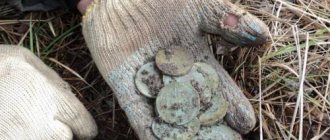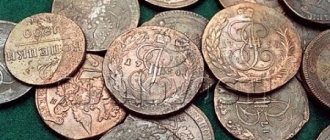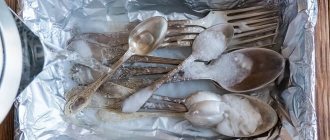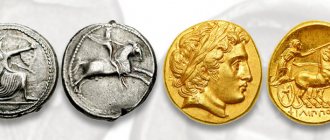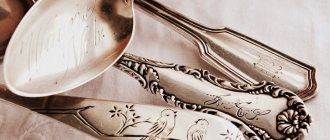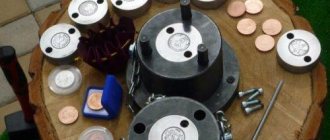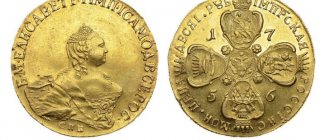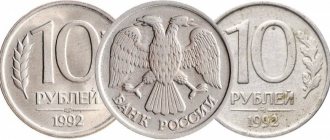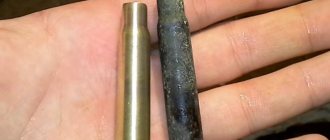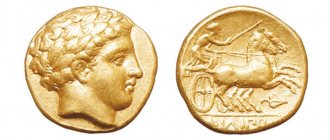Other articles 10 rubles bimetal before and after cleaning
Many novice collectors, or those who are just looking at a new field of collecting - numismatics, dream of returning the shine to their coins. Especially if these coins are in poor condition, very old, or out of circulation. There is especially a desire to cleanse those that have some value. If you decide to use cleaning, you must first try it on a coin of insignificant value. Moreover, it should be taken into account that different metals may react differently to cleaning methods.
What not to do
First of all, it is worth noting that you should never clean absolutely all coins to make your collection shine! They will certainly become more beautiful, but they will most likely lose their collectible value. The fact is that the condition of the coin depends not only on its purity, but to a much greater extent on the preservation of the relief. Any smoothing of parts, the formation of gouges from removing oxides, or even just the loss of slight roughness reduces the condition and, accordingly, the value. Let's consider barbaric cleaning methods, which are most often used by beginners: 1. Mechanical cleaning by friction with a rag, carpet, etc. (in common parlance – “cleaning with felt boots”). Sometimes GOI paste (green, like plasticine) can be used, but it only worsens the damage to the coin. GOI paste can only be used for certain types of jewelry (not antique), where shine is of paramount importance. In general, its main purpose is to clean optical lenses. 2. Rough dry cleaning with acids and other aggressive compounds. In addition to removing dirt and oxides, part of the surface disappears, and bumps and dents form. Any acids must be diluted with water (preferably distilled) in a ratio of at least 1/7. 3. Scratching a coin with metal or other objects in order to remove a layer of dirt. In this case, the surface deteriorates irrevocably, scratches and gouges appear. The method can only be used to remove adhered dirt, and only with a wooden object (for example, a toothpick). If the coin is not valuable, you can use a toothbrush, but be extremely careful.
Preparing to Clean Coins
Museum restorers have a rule that can be applied to coins: the process must be reversible. That is, it is necessary to remove only late layers without affecting the original surface. Guided by this rule, in most cases it is better not to clean the coin, but to leave it as is. But if the coin looks really bad, then cleaning should be done. For modern and Soviet coins, cleaning should be used if clearly visible stains appear on them, images are poorly visible, or there is dirt. For coins of imperial times and earlier, cleaning is used only in the case of large deposits of oxides that distort the appearance or threaten the coin. An even patina (noble) indicates its authenticity and centuries-old history, and a shiny coin from this time looks like a fake. Patina is also an additional protective shell that prevents exposure to the environment. Bringing back patina is a complex process that requires a lot of experience. For very old coins, for example ancient Russian ones, which are in very poor condition, the presence of a metal core should be taken into account. That is, the coin could be so oxidized that the metal itself completely disappeared, leaving only a crust of oxides. By removing this crust the coin will be lost. In addition to determining the metal, it is necessary to take into account the nature of the oxides. When interacting with reagents, elements in the layer can damage the coin. The rind of copper coins may contain copper chloride, which appears as green spots or a flat greenish color. Cuprous oxide has a reddish tint, and lead carbonate gives a light yellow tint. All of this must be removed to avoid further destruction, but each has its own method. Silver coins most often have blackness in hard-to-reach places, which is better not to touch, it does not pose any threat, and at the same time gives the silver a noble antique look. Gold rarely oxidizes, only as a result of a very aggressive environment. So-called “flowers” can form on noble metals - point stains that are very difficult to remove. This is the result of oxidation of impurities, unless the alloy fineness is very high. If the coins have not been cleaned at all, then before placing them in the collection, it is advisable to carefully (without rubbing!) wash them in soap and water, rinse and immediately wipe dry. Drying under a lamp is allowed, but if you use hard water, a residue may remain in this case. Sometimes simply wiping off fingerprints with a damp cloth is enough to prevent them from etching into the surface (this only applies to new coins and coins in excellent condition). Cleaning collectible coins of improved mintage (proof, BU, UNC) is highly not recommended, otherwise the surface can be easily damaged. It is better not to touch such coins at all and immediately place them in plastic capsules. For them, if cleaning is applicable, it is a very light chemical cleaning without any mechanical impact.
Sestertius Gordian III
Very difficult to clean. Petrified growths with inclusion of sand. I don’t clean the coin until it’s stamp clean; I prefer to leave at least a little time on it. In some cases, my coins look a little unpolished. I think this is more correct.
Proper Cleaning Methods
Coin cleaner
Cleaning with special means.
The most convenient and safest way for a beginner with little knowledge of chemistry. In numismatic stores you can purchase products for copper, silver, gold, brass, etc. It is not recommended to purchase a cleaner for metal products (not coins). The instructions usually describe the cleaning process, but most often it comes down to immersing the coins in liquid for several hours or minutes (depending on the contamination). You should not overexpose, otherwise the process of dissolving the metal may begin. Be sure to periodically turn over the coins. But you should only buy such a product when cleaning a large number of coins, otherwise the costs may not be justified. Cleaning copper coins:
Removing copper oxide (reddish deposit).
Immerse the coins (completely, otherwise the metal may be damaged) for several minutes in a 5-10% solution of ammonia or ammonium carbonate. Ammonia will also work. All these substances have a very pungent odor; you need to work more carefully. Removing copper chloride (green deposits or stains). A solution of citric acid or lemon juice is best. Leave it on for several hours until plaque removal begins, then rinse. After cleaning, check for the presence of tiny chloride particles. To do this, you need to take a container filled 1/3 with water and cover it with a plate with holes. Place coins on top of the plate and keep for up to 3 days. If droplets of liquid appear on the coins, cleaning must be repeated. Removing lead carbonate deposits (yellowish tint). Table vinegar or 9% acetic acid solution should be used. Such a deposit is rare, usually when coins are found next to lead products. Cleaning coins made of various metals:
Cleaning a coin with ammonia
Dry cleaning. To remove plaque, a 5-10% solution of formic or citric acid with soda is suitable, in which the coins should be kept from several minutes to several hours. The result should be checked regularly to avoid damage to the metal. The method is suitable for both ancient and modern coins. Electrolysis cleaning. Suitable for very heavily soiled or oxidized coins. It should be used in case of loss of distinguishable images, but it is important to remember that after cleaning, indentations may remain from the presence of oxides there, and the coin will no longer become new. If a coin has crystallized and no longer has a metal base, then it cannot be cleaned. The electrolysis method looks like this: a glass vessel (to better see the process) is filled with electrolyte (conductive liquid), the ends of low voltage wires (preferably 9-12 volts) with crocodiles are lowered into the jar, a metal object is placed on one (with a minus sign) crocodile (for example, a nail), and on the second with a plus sign (+) a coin is attached. If you mix up the terminals, then the coin, on the contrary, will begin to absorb particles of the nail. The electrolyte can be a weak saline solution (a teaspoon per glass) or a solution of citric acid. Correct connection will result in bubbles on the coin (not on the nail). You can only keep a coin in such a bath for a few minutes.
Electrolysis process in fragments and result
Ultrasonic bath. An invention of recent years, it is sold in numismatic stores. It works on the principle of microscopic vibration that destroys plaque. As a rule, it does not spoil coins, but the result is not always achieved. Separating stuck coins. Coins from ancient treasures may be stuck together due to the accretion of oxides among themselves. Under no circumstances should such a lump be broken or crushed so as not to destroy the coins. The lump is placed in a 5-10% sodium hydroxide solution, slightly heated (no more than 50 degrees). The coins are then easily separated. The procedure may have to be repeated several times. Acceleration of any cleaning is possible by heating the solution to 50-60 degrees Celsius, but control must be constant.
For coppers
The choice of processing method depends on the color of the patina. If it is cherry or brown, then we use an ammonia solution; if it is yellow, we need vinegar; if it is white, we use distilled water. You can clean a copper coin from black deposits at home using two means.
Vaseline oil
- Pour oil into the pan. (The standard volume of a bottle is 40 ml. Therefore, we determine the amount of oil based on the number of coins requiring processing).
- We put it on fire.
- Throw the products into boiling oil and hold them until the coating disappears.
- After boiling, cool them and wipe with alcohol.
- Dry with a soft cloth.
Peroxide + ammonia
- For 200 ml of water, take a teaspoon of ammonia and 30 ml of hydrogen peroxide.
- Mix the components and place the coins in the prepared solution for no more than 15 minutes.
- Afterwards, gently wipe them with a soft cloth.
Copper coins can be boiled in laundry soap. This is a gentle option that allows you to preserve collectible items without harming them.
After cleaning
The result of cleaning a copper coin by electrolysis
If the cleaning is successful and the coin has acquired a collectible appearance, it must be washed with soapy water, rinsed and gently blotted with a cloth. After this, let it dry for about 30 minutes and put it in a closed space (a bag with latches - a gripper, in an album, in a plastic capsule). Contact with air is harmful to metal, so the storage container should fit snugly around the coin and have no holes. You should also choose albums that are odorless, otherwise the fumes may lead to oxidation. The return of lost patina is possible using various chemical methods and folk methods. For example, you can add 50 g of copper sulfate and 5 g of potassium permanganate per liter of distilled water. Heat the solution until the first bubbles appear and place coins in it. Patina will begin to form quickly; it is important to remove the coins in time. This process requires experience and is recommended to be carried out on valuable coins only by a specialist. You can only touch coins with gloves or tweezers, so as not to leave sweat marks. Sometimes you need to change the location of the coin if the oxidation process has become noticeable on it. It's best not to store coin albums in new furniture, as the varnish can emit toxic fumes. Sometimes coins are waxed or varnished before storage. This is not recommended due to possible adverse contact of the substance with the metal. It is also undesirable to keep coins in a soap solution for a long time to avoid exposure to fatty acids. It is permissible to gently rub copper coins with chalk powder, after which the chalk must be carefully removed with a dry cloth. You can read opinions about cleaning and learn more about the results on the forum in the topic “Tips for cleaning coins”, as well as in the topic “Cleaning coins. What and how, so as not to spoil it? Photos for the article were provided by site users: drdd, Greenveresk, Romka1981, Roman959. Electrolysis method in photographs - user lisred.
Article last modified: 08/15/2017
Other articles
Workplace
The main thing is the microscope!
The best domestic options are: MBS-9, MBS-10, from Olbantsky with USB connectors - those that are more expensive
The main working tool is a scraper.
The steel triangular micro blade is made from dental burs that have served their purpose and have been tormented at us a lot.
As well as bristle brushes, brushes of various hairiness, whatever you like, I chose domestic bristles for myself; cotton swabs are also needed for wiping the object during cleaning.
And most importantly (I completely forgot the old one). Synthetic resin – PARALOID B72, for securing unstable areas of the object being cleared and initial fixation of the material.
And, perhaps most importantly, if you plan to clean an item mechanically, start thinking about preserving it as early as possible! The best way to preserve an item is to place it in a moist environment, such as a vacuum-sealed food container filled with wipes soaked in distilled water or a tray with cut-out lost-and-found compartments. Putting a find in a pocket along with other items means causing a lot of damage, the finds should lie separately and not touch each other, and moisture will prevent drying and thus the item will successfully end up on your desktop and you will have less work to preserve and subsequent clearing!
Comments:
I read this article.
Everything is described in some detail, but I’ll add a couple more recommendations. 1) to prepare liquid solutions, it is better to use distilled water (tap water contains many impurities, which reduces the quality of the solution, and in some cases causes electrolysis of the metal) 2) there is a product for cleaning coins (metals in general) called Trilon-B (disodium acid salt , there is soap (usually for children) with EDTA, the same thing only in a lower concentration), but you have to be careful, it can remove the patina, and therefore the collection value decreases; 3) many people recommend using WD-40 (I haven’t tried it, but they say it cleans oxides well, especially steel coins (if someone decides to clean coins this way, TRY IT ON NON-VALUABLE COINS first, and if possible, please report the result, because . I heard about the recommendations but did not try it myself, so I can’t vouch for the result.) Author: Skyline 08/30/2012 at 12:14:12
Forgot to add. Some collectors recommend varnishing coins with a water-based varnish to prevent further oxidation. If necessary, the varnish is easily washed off with water. I also heard, but did not try, so this method is at your own peril and risk.
Author: Skyline 08/30/2012 at 12:27:05
Newbies don't need to do this. Think 100 times.
12/18/2017 at 01:28:55
I wouldn’t recommend covering coins with varnish either. Any chemical exposure can be harmful.
Author: Admin 12/18/2017 at 02:55:55
To add a comment, register
